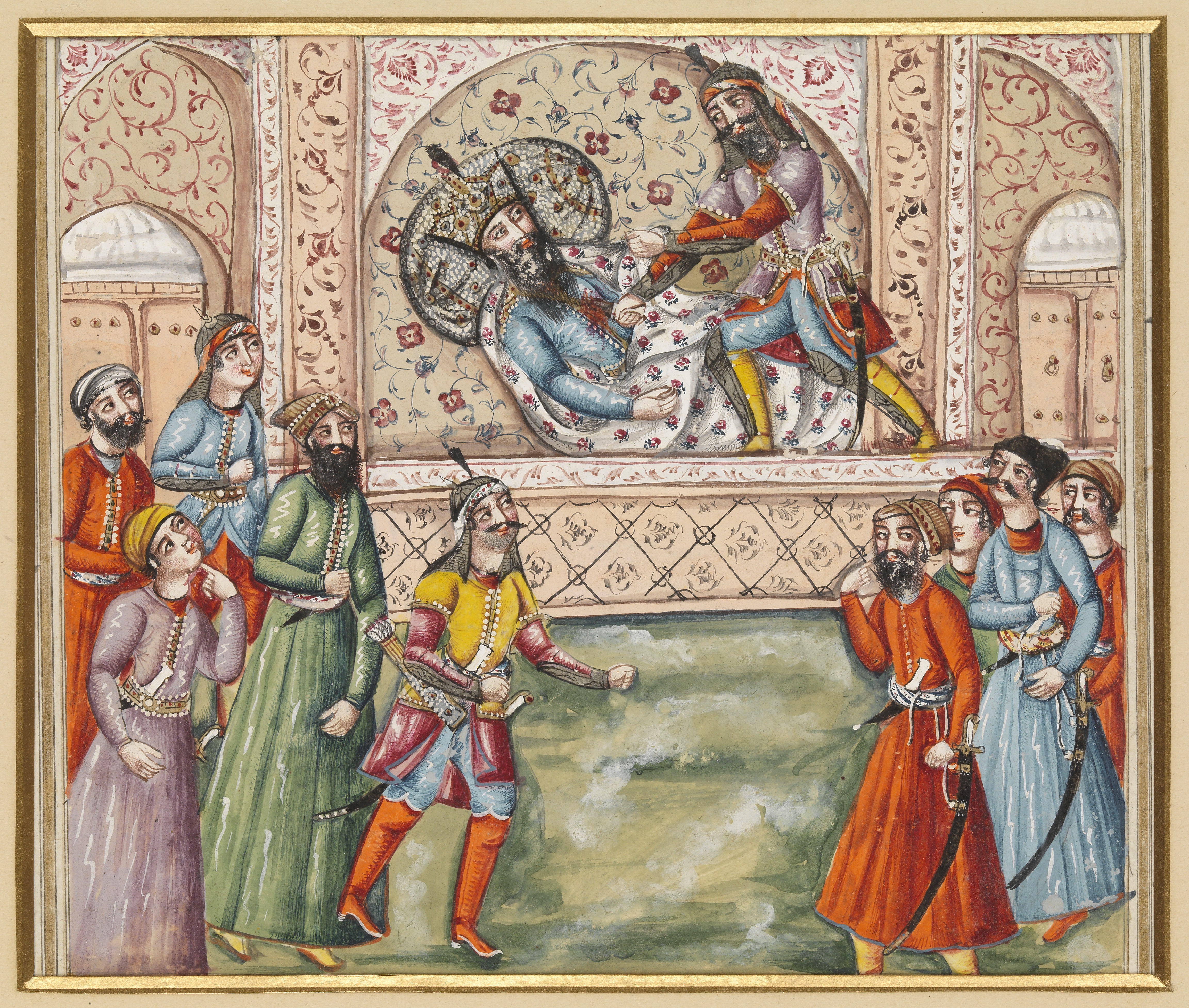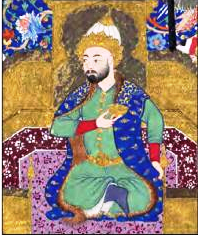Afrasiab I on:
[Wikipedia]
[Google]
[Amazon]
 Afrasiab ( fa, ''afrāsiyāb''; ae, Fraŋrasyan;
Afrasiab ( fa, ''afrāsiyāb''; ae, Fraŋrasyan;
 According to the ''
According to the ''
"Afrāsiāb"
''
Afrasiab featured in Rostam Comic Book
The battle of Rustam and Afrasiab
on Asian miniature {{Shahnameh Shahnameh characters
 Afrasiab ( fa, ''afrāsiyāb''; ae, Fraŋrasyan;
Afrasiab ( fa, ''afrāsiyāb''; ae, Fraŋrasyan; Middle-Persian
Middle Persian or Pahlavi, also known by its endonym Pārsīk or Pārsīg () in its later form, is a Western Middle Iranian language which became the literary language of the Sasanian Empire. For some time after the Sasanian collapse, Middle ...
: ''Frāsiyāv, Frāsiyāk'') is the name of the mythical king and hero of Turan
Turan ( ae, Tūiriiānəm, pal, Tūrān; fa, توران, Turân, , "The Land of Tur") is a historical region in Central Asia. The term is of Iranian origin and may refer to a particular prehistoric human settlement, a historic geographical re ...
. He is the main antagonist of the Persian epic Shahnameh
The ''Shahnameh'' or ''Shahnama'' ( fa, شاهنامه, Šāhnāme, lit=The Book of Kings, ) is a long epic poem written by the Persian poet Ferdowsi between c. 977 and 1010 CE and is the national epic of Greater Iran. Consisting of some 50,00 ...
, written by Ferdowsi
Abul-Qâsem Ferdowsi Tusi ( fa, ; 940 – 1019/1025 CE), also Firdawsi or Ferdowsi (), was a Persians, Persian poet and the author of ''Shahnameh'' ("Book of Kings"), which is one of the world's longest epic poetry, epic poems created by a sin ...
.
The mythical king and hero
 According to the ''
According to the ''Shahnameh
The ''Shahnameh'' or ''Shahnama'' ( fa, شاهنامه, Šāhnāme, lit=The Book of Kings, ) is a long epic poem written by the Persian poet Ferdowsi between c. 977 and 1010 CE and is the national epic of Greater Iran. Consisting of some 50,00 ...
'' (''Book of Kings''), by the Persian epic poet Ferdowsi
Abul-Qâsem Ferdowsi Tusi ( fa, ; 940 – 1019/1025 CE), also Firdawsi or Ferdowsi (), was a Persians, Persian poet and the author of ''Shahnameh'' ("Book of Kings"), which is one of the world's longest epic poetry, epic poems created by a sin ...
, Afrasiab was the king and hero of Turan and an archenemy of Iran. In Iranian mythology, Afrasiab is considered by far the most prominent of all Turanian {{Short description, List of groups of people
Turanian is a term that has been used in reference to diverse groups of people. It has had currency in Turanism, Pan-Turkism, and historic Turkish nationalism.
Many of the uses of the word are obsolete. ...
kings; he is a formidable warrior, a skilful general, and an agent of Ahriman
Angra Mainyu (; Avestan: 𐬀𐬢𐬭𐬀⸱𐬨𐬀𐬌𐬥𐬌𐬌𐬎 ''Aŋra Mainiiu'') is the Avestan-language name of Zoroastrianism's hypostasis of the "destructive/evil spirit" and the main adversary in Zoroastrianism either of th ...
, who is endowed with magical powers of deception to destroy Iranian civilization.Yarshater, E., "Afrasiab", ''Encyclopædia Iranica
''Encyclopædia Iranica'' is a project whose goal is to create a comprehensive and authoritative English language encyclopedia about the history, culture, and civilization of Iranian peoples from prehistory to modern times.
Scope
The ''Encycl ...
'' - digital library; accessed January 18, 2007. He is brother to Garsivaz
Garsivaz (also Garsiwaz, Gersiwaz or Karsivaz) ( fa, گَرسیوَز ) is a mythical Turanian character, referred to in ''Shahnameh'' ('Book of Kings') by the Persian epic-poet Ferdowsi. He is the brother of Afrasiab
Afrasiab ( fa, ''afrāsi ...
, and the son of Pashang
Pashang ( fa, پَشَنْگ) is the name of two separate characters in Persian Mythology. According to Ferdowsi's epic the ''Shahnameh'', he is of the race of Tur the son of Fereydun and the father of Afrasiab. He was an early king of Turan. In ...
.
According to Islamic sources, Afrasiab was a descendant of Tūr (Avestan: ''Tūriya-''), one of the three sons of the Iranian mythical King Fereydun
use both this parameter and , birth_date to display the person's date of birth, date of death, and age at death) -->
, death_place =
, death_cause =
, resting_place =
, resting_place_coordinates =
, burial_place ...
(the other two sons being Salm
Salm may refer to
People
* Constance de Salm (1767–1845), poet and miscellaneous writer; through her second marriage, she became Princess of Salm-Dyck
* Salm ibn Ziyad, an Umayyad governor of Khurasan and Sijistan
* House of Salm, a European ...
and Iraj
Iraj ( fa, ایرج - ʾīraj; Middle Persian, Pahlavi: ērič; from Avestan language, Avestan: 𐬀𐬌𐬭𐬌𐬌𐬀 airiia, literally "Aryan") is the seventh Shah of the Pishdadian dynasty, depicted in the ''Shahnameh''. Based on Persian myth ...
). In ''Bundahishn
''Bundahishn'' (Avestan: , "Primal Creation") is the name traditionally given to an encyclopedic collection of Zoroastrian cosmogony and cosmology written in Book Pahlavi. The original name of the work is not known.
Although the ''Bundahishn'' d ...
'', he is named as the seventh grandson of Tūr. In Avestan traditions, his common epithet ''mairya-'' (deceitful, villainous) can be interpreted as meaning 'an evil
Evil, in a general sense, is defined as the opposite or absence of good. It can be an extremely broad concept, although in everyday usage it is often more narrowly used to talk about profound wickedness and against common good. It is general ...
man'. He lived in a subterranean fortress made of metal, called Hanakana.
According to Avestan sources, Afrasiab was killed by Haoma
''Haoma'' (; Avestan: 𐬵𐬀𐬊𐬨𐬀) is a divine plant in Zoroastrianism and in later Persian culture and mythology. ''Haoma'' has its origins in Indo-Iranian religion and is the cognate of Vedic ''soma''.
Etymology
Both Avestan ''haoma'' ...
near the ''Čīčhast'' (possibly either referring to Lake Hamun
Lake Hāmūn ( fa, دریاچه هامون, ''Daryācheh-ye Hāmūn''; ps, هامون ډنډ), or the Hamoun Oasis, is a seasonal lake and wetlands in the endorheic Sīstān Basin in the Sistan region on the Afghanistan–Iran border. In Iran, ...
in Sistan
Sistān ( fa, سیستان), known in ancient times as Sakastān ( fa, سَكاستان, "the land of the Saka"), is a historical and geographical region in present-day Eastern Iran ( Sistan and Baluchestan Province) and Southern Afghanistan (N ...
or some unknown lake in today's Central Asia), and according to Shahnameh he met his death in a cave known as the Hang-e Afrasiab, or the dying place of Afrasiab, on a mountaintop in Azerbaijan
Azerbaijan (, ; az, Azərbaycan ), officially the Republic of Azerbaijan, , also sometimes officially called the Azerbaijan Republic is a transcontinental country located at the boundary of Eastern Europe and Western Asia. It is a part of th ...
. The fugitive Afrasiab, having been repeatedly defeated by the armies of his adversary, the mythical King of Iran Kay Khosrow
Kay Khosrow ( fa, کیخسرو) is a legendary king of Iran of Kayanian dynasty and a character in the Persian epic book, ''Shahnameh''. He was the son of the Iranian prince Siavash who married princess Farangis of Turan while in exile. Befo ...
(who happened to be his own grandson, through his daughter Farangis
Farangis ( fa, فَرَنگیس) or Frigis ( fa, فریگیس) is a female character in the Persian epic ''Shahnameh''. She is the eldest daughter of Afrasiab, king of Turan. She is also the second and favourite wife of Siyâvash, the saintlike ...
), wandered wretchedly and fearfully around, and eventually took refuge in this cave and died.
Hypotheses
Ernst Hertzfeld believed that the nameParsondes Parsondes was the king of the Cadusii, who, according to Ctesias, was a Mede of Persian origin.
Name
The name Parsondes probably comes from the important city of Parsindu, which was located among the mountains of Namri, on the road to Ecbatana. ...
is etymologically identical to the name Afrasiab. Tabari
( ar, أبو جعفر محمد بن جرير بن يزيد الطبري), more commonly known as al-Ṭabarī (), was a Muslim historian and scholar from Amol, Tabaristan. Among the most prominent figures of the Islamic Golden Age, al-Tabari i ...
in his works mentions the derivative Afrasiab / Aspandiat under the name of the Hephtalite king Akhshunvar or Akhshunvaz.
See also
*Afrasiyab (Samarkand)
Afrasiyab ( uz, Afrosiyob),( fa, ''afrāsiyāb'') is an ancient site of Northern Samarkand, present day Uzbekistan, that was occupied from c. 500 BC to 1220 AD prior to the Mongol invasion in the 13th century.Archaeological Research in Central A ...
* Afrasiab Museum of Samarkand
Afrasiab Museum of Samarkand ( Uzbek: ''Afrosiyob-Samarqand shahar tarixi muzeyi'') is a museum located at the historical site of Afrasiyab, one of the largest archaeological sites in the world and the ancient city that was destroyed by the Mongo ...
* Alp Er Tunga
Alp Er Tunga or Alp Er Tonğa (Alp "brave, hero, conqueror, warrior", Er "man, male, soldier, Tom", Tonğa "Siberian tiger") is a mythical Turkic hero who was mentioned in Mahmud al-Kashgari's Dīwān Lughāt al-Turk, Yusuf Balasaguni's Kutadgu ...
References
External links
*Ehsan Yarshater
Ehsan Yarshater ( fa, احسان يارشاطر, April 3, 1920 – September 1, 2018) was an Iranian historian and linguist who specialized in Iranology. He was the founder and director of The Center for Iranian Studies, and Hagop Kevorkian Profe ...
"Afrāsiāb"
''
Encyclopædia Iranica
''Encyclopædia Iranica'' is a project whose goal is to create a comprehensive and authoritative English language encyclopedia about the history, culture, and civilization of Iranian peoples from prehistory to modern times.
Scope
The ''Encycl ...
''
Afrasiab featured in Rostam Comic Book
The battle of Rustam and Afrasiab
on Asian miniature {{Shahnameh Shahnameh characters